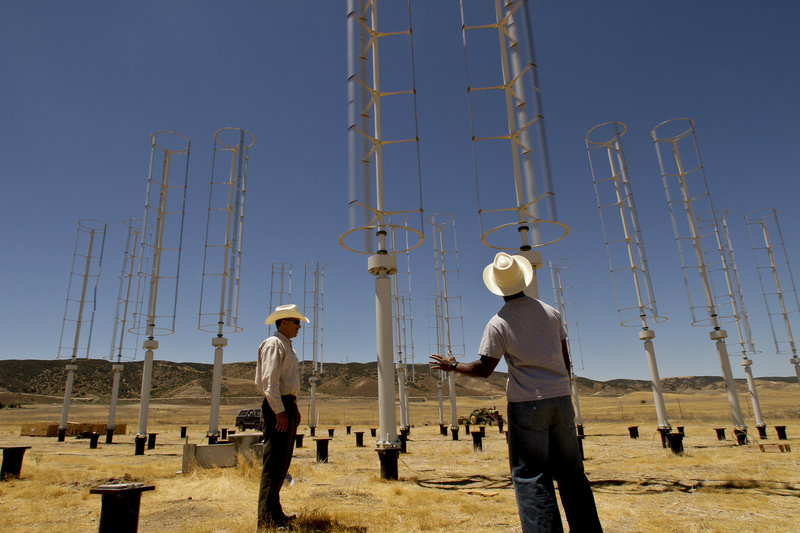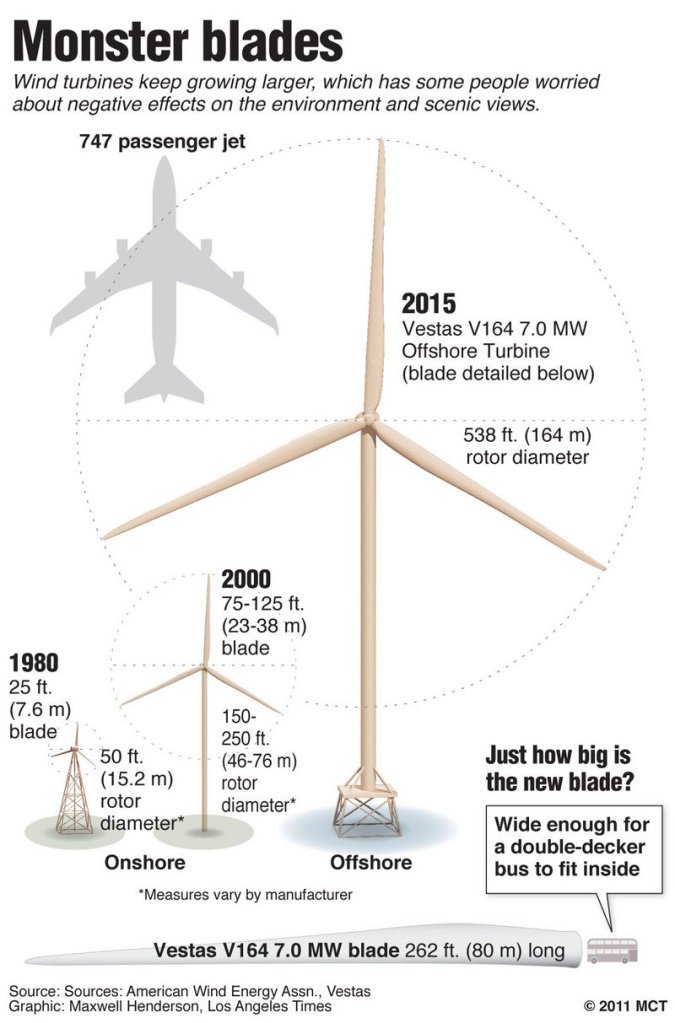LOS ANGELES – Wind turbines are getting really big — some with blades as long as a football field — and more powerful, often generating 50 times more electricity than the first generation of wind power machines built in the 1980s.
But scientists are also studying how to harness the wind in different ways that could help allay concerns that today’s turbines are unattractive, noisy and sometimes even dangerous.
Already in the works: Turbines that float and turbines that fly. Turbines without blades and turbines with blades fat enough to fit a double-decker bus inside.
They won’t just be on hillsides either. Some will be in the ocean, while others will be on rooftops and light poles. A few will even be in the sky.
One design was inspired by the humble bumblebee.
Sabri Sansoy, an MIT graduate and former rocket engineer, has built a 19-foot-tall prototype whose blades, rather than spin in a circle, move in a figure-eight motion like the insect’s wings. Sansoy hopes the design will generate more electricity than turbines of similar size.
“I’ve been called everything from brilliant to a nincompoop over this,” said Sansoy, whose Marina del Rey, Calif., company Green Wavelength is looking to commercialize the technology.
But “there’s a lot of people interested in this kind of thing, taking energy out of the wind,” he said.
That’s because there’s a lot of money being poured into finding ways to ease off coal-based electricity. Last year, the Department of Energy set aside a record $79 million for its wind program budget — nearly $20 million more than its previous top allotment in 1980.
General Electric Co., which makes half of the turbines in the U.S., has invested more than $1.5 billion developing renewable energy technology since entering the wind business in 2002. Google Inc., the Internet search giant, and its philanthropic arm have plunged millions of dollars into new wind concepts.
At the moment, most turbines are designed to look like streamlined windmills: Blades connected to a rotor, usually mounted high on a tower to capture stronger gusts, spin like propellers in the wind. The rotor helps turn a shaft connected to a generator, which produces electricity.
But companies are coming up with innovative variations.
An Alameda, Calif., company, Makani Power Inc., is developing a kite-like contraption that generates electricity as it whips in circles in the wind.
Another firm, Magenn Power Inc., has built a giant spinning blimp with generators affixed to each end. It somewhat resembles a giant inflatable hamster wheel.
Some machines could double as art installations. Poway, Calif.-based Helix Wind Corp.’s turbine looks like a spiral staircase wrapped in a white sheet. Another model, from WindTronics, evokes a large bicycle wheel — or Sauron’s eye from “The Lord of the Rings.”
Although many current installations are limited to sites with just the right mix of topography and wind speed, designers are starting to create turbines that can adapt to a wide range of terrains.
One Italian proposal involves wind turbines being built between the pillars of a bridge. Last month, turbine manufacturer Vestas said it adapted military stealth technology that can keep turbines from interfering with airport and army radar systems, potentially opening up new sites.
The popularity of rooftop solar panels has sparked a surge of smaller wind turbines that can sit atop buildings. Municipalities around the country are gradually updating zoning rules to allow for the more compact models. Technology like the not-quite-6-foot-tall Eddy from Urban Green Energy Inc. has popped up at trade shows in China and the Consumer Electronics Show in Las Vegas.
Turbines could also end up in the oceans as developers try to tap powerful sea breezes. Researchers say those machines could generate many times more power than land-based ones.
In March, Vestas announced a 7-megawatt offshore turbine that will be more than 600 feet tall from the blade tip to the bottom of the tower. The blades will sweep in a circle larger than the London Eye Ferris wheel.
The monstrous machines, to be made mostly with recyclable materials, will be mass produced by 2015, Vestas said.
One turbine in Germany spans nearly 700 feet from the bottom of the tower to the blade tip. Other developers say that land-based turbines with 300-foot blades may be ready within a decade.
But some said scaling up isn’t always the way to go.
“The wind industry’s central tenet now is that bigger is better,” said John O. Dabiri, an aeronautics professor who runs Caltech’s Center for Bioinspired Engineering. “It certainly goes against conventional wisdom, but we’re taking the opposite perspective.”
But some of the newfangled models may not go far, said Nancy Rader, executive director of the California Wind Energy Association. The technology with the most longevity probably will be variations of current turbines, she said.
“In 20 years, I think it’s going to be more of the same,” she said.
Send questions/comments to the editors.




Success. Please wait for the page to reload. If the page does not reload within 5 seconds, please refresh the page.
Enter your email and password to access comments.
Hi, to comment on stories you must . This profile is in addition to your subscription and website login.
Already have a commenting profile? .
Invalid username/password.
Please check your email to confirm and complete your registration.
Only subscribers are eligible to post comments. Please subscribe or login first for digital access. Here’s why.
Use the form below to reset your password. When you've submitted your account email, we will send an email with a reset code.